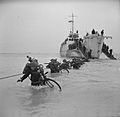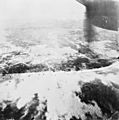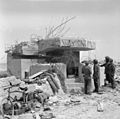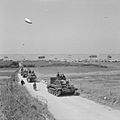Gold Beach facts for kids
Quick facts for kids Gold Beach |
|||||||
|---|---|---|---|---|---|---|---|
| Part of the Normandy landings | |||||||
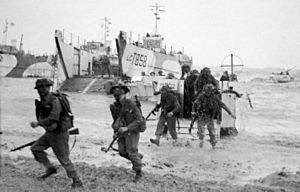 Men of No. 47 Commando landing on Gold near La Rivière |
|||||||
|
|||||||
| Belligerents | |||||||
|
|||||||
| Commanders and leaders | |||||||
| Units involved | |||||||
|
|
||||||
| Casualties and losses | |||||||
| 1,000–1,100 (350 killed) | Unknown | ||||||
Gold, commonly known as Gold Beach, was the code name for one of the five areas of the Allied invasion of German-occupied France in the Normandy landings on 6 June 1944, during the Second World War.
Gold, the central of the five areas, was located between Port-en-Bessin on the west and La Rivière on the east. High cliffs at the western end of the zone meant that the landings took place on the flat section between Le Hamel and La Rivière, in the sectors code-named Jig and King.
Taking Gold was to be the responsibility of the British Army, with sea transport, mine sweeping, and a naval bombardment force provided by the Royal Navy as well as elements from the Dutch, Polish and other Allied navies.
The objectives at Gold were to secure a beachhead, move west to capture Arromanches and establish contact with the American forces at Omaha, capture Bayeux and the small port at Port-en-Bessin, and to link up with the Canadian forces at Juno to the east. Forces attacking Gold faced elements of the German 352nd Infantry Division and German 716th Infantry Division. About 2,000 men were stationed in the immediate area. Improvements to fortifications along the Normandy coast had been undertaken under the leadership of Generalfeldmarschall Erwin Rommel beginning in October 1943.
On D-Day at Gold, naval bombardment got underway at 05:30, and amphibious landings commenced at 07:25. High winds made conditions difficult for the landing craft, and the amphibious DD tanks were released close to shore or directly on the beach instead of further out as planned. Three of the four guns in a large emplacement at the Longues-sur-Mer battery were disabled by direct hits from the cruisers Ajax and Argonaut at 06:20. The fourth gun resumed firing intermittently in the afternoon, and its garrison surrendered on 7 June. Aerial attacks had failed to hit the Le Hamel strongpoint, which had its embrasure facing east to provide enfilade fire along the beach and had a thick concrete wall on the seaward side. Its 75 mm gun continued to do damage until 16:00, when an Armoured Vehicle Royal Engineers (AVRE) tank fired a large petard bomb into its rear entrance. A second casemated emplacement at La Rivière containing an 88 mm gun was neutralised by a tank at 07:30.
Meanwhile, infantry began clearing the heavily fortified houses along the shore and advanced on targets further inland. The British Commandos of No. 47 (Royal Marine) Commando advanced on Port-en-Bessin and captured it on 7 June in the Battle of Port-en-Bessin. On the western flank, the 1st Battalion, Hampshire Regiment captured Arromanches (future site of one of the artificial Mulberry harbours), and 69th Infantry Brigade on the eastern flank made contact with the Canadian forces at Juno. Company Sergeant Major Stanley Hollis received the only Victoria Cross awarded on D-Day for his actions while attacking two pillboxes at the Mont Fleury battery. Due to stiff resistance from the German 352nd Infantry Division, Bayeux was not captured until the next day. British casualties at Gold are estimated at 1,000–1,100. German casualties are unknown.
Images for kids
-
Operations in the Battle for Caen
See also
 In Spanish: Playa de Gold para niños
In Spanish: Playa de Gold para niños



